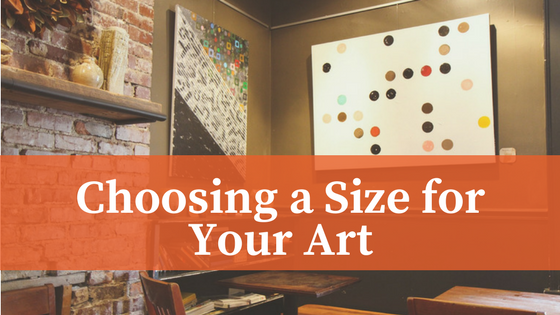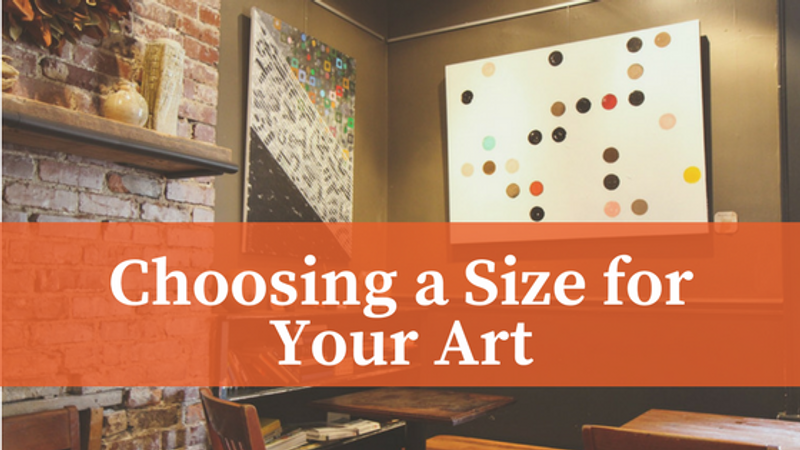
Whether you’re hanging a framed poster, a one-of-a-kind painting, a canvas print, or your own photographs any interior designer will agree that adding your own sense of style to the walls with art and photography is a great way to bring character and charm to a space. The kicker is often deciding what size you should place where, and understanding from a design standpoint what happens aesthetically when you place something in the wrong spot.
When hanging wall art , consider the size and shape of the room - but further, orientation and shape of the art you’re hanging, as well as the atmosphere you’re trying to promote and nurture in the room. Allow your own personal tastes to come through, but keep in mind, some pieces of wall art won’t suit where you want to put them.
To maximize the statement, we’ve compiled a guide of things to consider when outfitting your space with art.
Size of Artwork
When picking art for most walls and rooms, bigger is usually better. When you’re investing in wall-art, one of the worst mistakes homeowners can make is placing a great piece on a wall that’s too big for the size of the piece. Being able to recognize when a piece of art deserves to be placed on a smaller wall is key to making your wall art pop.
Think about ceiling height as well. 11 or 12 foot ceilings, or vaulted ceilings can easily accommodate huge pieces of art, and hanging a conventionally sized photograph or painting will inevitably make the room feel barren. In a small room with low-hanging ceilings, a small piece will fit well, balancing out and even helping to maximize perceived space. The type of art you hang also helps to dictate recommended sizing - a postmodern or contemporary piece of art, or framed black and white street photography should be big to maximize the impact and the statement you're aiming to make.
The wall itself matters as well. Hanging wall art above the fireplace mantel or above furniture like a couch or workspace desk should measure about three quarters the width of the furniture itself to balance size, and should be hung about 6-12 inches above the top of the furniture itself so it doesn’t get visually sucked to the floor by the eye. Above a mantelpiece, a piece of wall art should measure about 80% of the width of the mantel, and should be more-or-less centered vertically. Another tip is to hang art that’s the approximate size of the fireplace opening to continue an uninterrupted upward gaze.
If all you have is smaller pieces, that’s OK - it’s possible to tastefully orchestrate a number of small pieces on a large wall by pinning a tightly grouped even number of wall art pieces to balance out the large wall. And, larger walls can handle larger spaces in between these small pieces. In small spaces, tightly grouped smaller pieces of art give a kind of window effect in spots like a stair landing, or a bathroom wall adjacent to a window.
The Type of Room
It should be no surprise that bigger rooms dictate bigger pieces of wall art, but there’s also a case to be made for a pseudo art gallery style of presentation. As a general rule, follow the gallery mantra by hanging your wall art so that the centre of the piece is directly at eye level, and think of the room as a gallery space wherein all of your pieces group can be viewed as a single unit.
To create seamless gallery walls of tightly bunched pieces, take your time before hanging them and lay them all of on the floor first. In the event they’re all different shapes and sizes, having the larger mosaic pieced together before you start putting holes in the wall is key to custom tailoring and perfecting your overall design.
There are a few tips and tricks to hanging larger piece of art in different rooms as well. A dining room can have pieces hung slightly lower than say, the family room - as you’ll probably be sitting for the majority of time when in the room itself. In play rooms or living rooms, hanging smaller pieces a little higher on the same will help to discourage any tiny, curious fingers from grabbing at the frame.
If you’re dealing with how to hang a number of pieces in a room that requires perfect symmetrical placement, balancing pieces similar in size, shape and subject matter helps create visual harmony over couches, or straddling a wall-mounted shelf. Similarly, you can pair pieces that are all different sizes, but carry a similar theme to create drama.
What Should You Hang?
Knowing how big your pieces should be is great, and realizing that the room plays a pivotal role in promoting energy is key - but what if you don’t know what you should hang in the first place? There’s no right or wrong answer to discovering your taste. Like wine, go with what you like - there’s no reason a certain piece of art should trump another because of artistic merit or hierarchy.
If you’re in the market for an update, a few trends in wall art include:
Blue Art
Blue is an in-demand colour for 2017. It can promote peacefulness, serenity, and is perfect to complement another trend for interior design - greens for walls. Green is in for 2017 as it's a refreshed and revitalized colour, signalling a fresh start. Blues complement greens, whites and creams.
Pale Pinks
A Pantone colour of the year for 2016, Rose Quartz is an old favourite enjoying some recharged time in the limelight. It’s great for embracing a sophisticated elegance, and isn’t the “girly” colour we associate with pinks of old. It pairs well with wooden accents , neutral grays and metallic surfaces.
Street Photography
In 2015, sales of street-based photography jumped by 41% in part because of the emotional responses generated by social media feeds and artistic news-style reporting. Recreating emotionally-charged and artistic scenes in the home lies in an images ability to hold onto lasting appeal.
Patterns
Abstract painting prints from notable artists such as Jackson Pollock can be both therapeutic, and can spark engaging discussions - great for entertaining. Likewise, the idea of a pattern may be in the overall style of a specific artist, painter or photographer. A stylized Shepard Fairey image, for example, can generate powerful punch in a bland room, in part because of their intriguing content, and their dedication to bold patterns - both systematic and chaotic. When you’re hanging a pattern, make sure to be conscious of where it’s being hung. A powerful pattern shouldn’t be put in the bedroom where you’ll seek solace and calm.
Sculpture
Don’t confuse sculpture a strictly floor-based artform. Many 3-dimensional art pieces can be adapted for use on walls and sculpture art went up 20% in 2016, signalling that shelf art, as well as mountable 3D art is on the rise. Consider a cardboard or ceramic taxidermied deer head for above the mantle.

